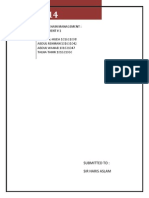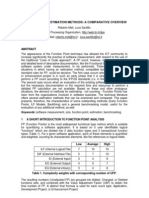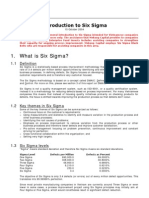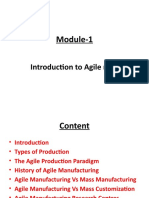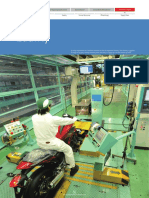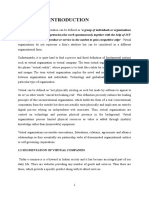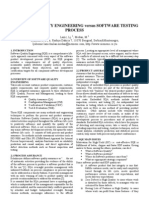Problem Statement QFD
Problem Statement QFD
Uploaded by
Abdul RehmanCopyright:
Available Formats
Problem Statement QFD
Problem Statement QFD
Uploaded by
Abdul RehmanOriginal Description:
Original Title
Copyright
Available Formats
Share this document
Did you find this document useful?
Is this content inappropriate?
Copyright:
Available Formats
Problem Statement QFD
Problem Statement QFD
Uploaded by
Abdul RehmanCopyright:
Available Formats
Problem statement:
To involve the customer satistification in desgin of the product. And match it with technical
requirements. To provide more reliable and better product.
INTRODUCTION
Dr. Mizuno, professor emeritus of the Tokyo Institute of Technology, is credited with initiating the
quality function deployment (QFD) system. The first application of QFD was at Mitsubishi, Heavy
Industries, Ltd., in the Kobe Shipyard, Japan, in 1972. After four years of case study development,
refinement, and training, QFD was successfully implemented in the production of mini-vans by
Toyota. Using 1977 as a base, a 20% reduction in startup costs was reported in the launch of the
new van in October 1979, a 38% reduction by November 1982, and a cumulative 61% reduction
by April 1984. Quality function deployment was first introduced in the United States in 1984 by
Dr. Clausing of Xerox. QFD can be applied to practically any manufacturing or service industry. It
has become a standard practice by most leading organizations, who also require it of their
suppliers.
Quality function deployment (QFD) is a planning tool used to fulfill customer expectations.
It is a disciplined approach to product design, engineering, and production and provides in-depth
evaluation of a product. An organization that correctly implements QFD can improve engineering
knowledge, productivity, and quality and reduce costs, product development time, and engineering
changes.
Quality function deployment focuses on customer expectations or requirements, often
referred to as the voice of the customer. It is employed to translate customer expectations, in terms
of specific requirements, into directions and actions, in terms of engineering characteristics, that
can be deployed through
Product planning
Part development
Process planning
Production planning
Service
Quality function deployment is a team-based management tool in which the customer
expectations are used to drive the product development process. Conflicting characteristics or
requirements are identified early in the QFD process and can be resolved before production.
Organizations today use market research to decide on what to produce to satisfy customer
requirements. Some customer requirements adversely affect others, and customers often cannot
explain their expectations. Confusion and misinterpretation are also a problem while a product
moves from marketing to design to engineering to manufacturing. This activity is where the voice
of the customer becomes lost and the voice of the organization adversely enters the product design.
Instead of working on what the customer expects, work is concentrated on fixing what the
customer does not want. In other words, it is not productive to improve something the customer did
not want initially. By implementing QFD, an organization is guaranteed to implement the voice of
the customer in the final product.
Quality function deployment helps identify new quality technology and job functions to
carry out operations. This tool provides a historic reference to enhance future technology and
prevent design errors. QFD is primarily a set of graphically oriented planning matrices that are
used as the basis for decisions affecting any phase of the product development cycle. Results of
QFD are measured based on the number of design and engineering changes, time to market, cost,
and quality. It is considered by many experts to be a perfect blueprint for concurrent engineering.
Quality function deployment enables the design phase to concentrate on the customer
requirements, thereby spending less time on redesign and modifications. The saved time has
been estimated at one-third to one-half of the time taken for redesign and modification using
traditional means. This saving means reduced development cost and also additional income
because the product enters the market sooner.
BENEFITS OF QFD
Quality function deployment was originally implemented to reduce start-up costs. Organizations
using QFD have reported a reduced product development time. For example, U.S. car
manufacturers of the late 1980s to early 1990s need an average of five years to put a product on the
market, from drawing board to showroom, whereas Honda can put a new product on the market in
two and a half years and Toyota does it in three years. Both organizations credit this reduced time
to the use of QFD. Product quality and, consequently, customer satisfaction improves with QFD
due to numerous factors depicted in Figure 111.
Customer Driven
Quality function deployment looks past the usual customer response and attempts to define the
requirements in a set of basic needs, which are compared to all competitive information. All
competitors are evaluated equally from customer and technical perspectives. This information
can then be prioritized using a Pareto diagram. Management can then place resources where they
will be the most beneficial in improving quality. Also, QFD takes the experience and information
that are available within an organization and puts them together as a structured format that is
easy to assimilate. This is important when an organization employee leaves a particular project
and a new employee is hired.
Reduces Implementation Time
Fewer engineering changes are needed when using QFD, and, when used properly, all conflicting
design requirements can be identified and addressed prior to production. This results in a reduction
in retooling, operator training, and changes in traditional quality control measures. By using QFD,
critical items are identified and can be monitored from product inception to production. Toyota
reports that the quality of their product has improved by one third since the implementation of
QFD.
THE VOICE OF THE CUSTOMER
Because QFD concentrates on customer expectations and needs, a considerable amount of effort
is put into research to determine customer expectations. This process increases the initial
planning stage of the project definition phase in the development cycle. But the result is a total
reduction of the overall cycle time in bringing to the market a product that satisfies the customer.
The driving force behind QFD is that the customer dictates the attributes of a product.
Customer satisfaction, like quality, is defined as meeting or exceeding customer expectations.
Words used by the customers to describe their expectations are often referred to as the voice of the
customer. Sources for determining customer expectations are focus groups, surveys, complaints,
consultants, standards, and federal regulations. Frequently, customer expectations are vague and
general in nature. It is the job of the QFD team to break down these customer expectations into
more specific customer requirements. Customer requirements must be taken literally and not
incorrectly translated into what organization officials desire.
Quality function deployment begins with marketing to determine what exactly the customer
desires from a product. During the collection of information, the QFD team must continually ask
and answer numerous questions, such as
What does the customer really want?
What are the customers expectations?
Are the customers expectations used to drive the design process?
What can the design team do to achieve customer satisfaction?
CUSTOMER
DRIVEN
REDUCES
IMPLEMENTATION
TIME
Documents rationale for design
Is easy to assimilate
Adds structure to the information
Adapts to changes (a living document)
Provides framework for sensitivity analysis
PROVIDES
DOCUMENTATION
PROMOTES
TEAMWORK
Creates focus on customer requirements
Uses competitive information effectively
Prioritizes resources
Identifies items that can be acted upon
Structures resident experience/information
Decreases midstream design change
Limits post introduction problems
Avoids future development redundancies
Identifies future application opportunities
Surfaces missing assumptions
Based on concensus
Creates communication at interfaces
Identifies actions at interfaces
Creates global view out of details
There are many different types of customer information and ways that an organization can
collect data, as shown in Figure 112. The organization can search (solicited) for the
information, or the information can be volunteered (unsolicited) to the organization. Solicited
and unsolicited information can be further categorized into measurable (quantitative) or
subjective (qualitative) data. Furthermore, qualitative information can be found in a routine
(structured) manner or haphazard (random) manner.
Figure 112 Types of customer information and how to collect it
Reproduced with permission from James L. Brossert, Quality Function DeploymentA Practitioners Approach
(Milwaukee, Wisc.: ASQC Quality Press, 1991).
Customer information, sources, and ways an organization can collect data can be briefly stated as
follows:
Solicited, measurable, and routine data are typically found by customer surveys, market
surveys, and trade trials, working with preferred customers, analyzing products from
other manufacturers, and buying back products from the field. This information tells
an organization how it is performing in the current market.
Unsolicited, measurable, and routine data tend to take the form of customer complaints
or lawsuits. This information is generally disliked; however, it provides valuable
learning information.
Solicited, subjective, and routine data are usually gathered from focus groups. The
object of these focus groups is to find out the likes, dislikes, trends, and opinions
about current and future products.
Solicited, subjective, and haphazard data are usually gathered from trade visits,
customers visits, and independent consultants. These types of data can be very useful;
Quantitative
Structured
Unsolicited Solicited
Qualitative
Random
Trade Visits
Customer Visits
Consultants
Complaint Reports
Organizations Standards
Government Regulations
Lawsuits
Focus Groups
Sales Force
Training Programs
Conventions
Trade Journals
Trade Shows
Vendors
Suppliers
Academic
Employees
Hot Lines
Surveys
Customer Tests
Trade Trials
Preferred Customers
OM Testing
Product Purchase Survey
Customer Audits
Lagging Leading
however, they can also be misleading, depending on the quantity and frequency of
information.
Unsolicited, subjective, and haphazard data are typically obtained from conventions,
vendors, suppliers, and employees. This information is very valuable and often relates
the true voice of the customer.
The goal of QFD is not only to meet as many customer expectations and needs as possible,
but also to exceed customer expectations. Each QFD team must make its product either more
appealing than the existing product or more appealing than the product of a competitor. This
situation implies that the team has to introduce an expectation or need in its product that the
customer is not expecting but would appreciate. For example, cup holders were put into
automobiles as an extra bonus, but customers liked them so well that they are now expected in all
new automobiles.
Methodology :
Tools of QFD
Matrix diagrams, which are very useful to organize the data collected, help to
facilitate the improvement process. They can be used to display information about the
degree to which employee expectations are being met and the resources that exist to
meet those expectations. The structure in which QFD uses to organize information is
known as the House of Quality.
In its broadest sense, the QFD House of Quality displays the relationship between
dependent (WHATS) and independent (HOWS) variables (Woods, 1994) [8]. Figure 1
shows the typical House of Quality.
This House of Quality should be created by a team of people with first-hand
knowledge of both company capabilities and the expectations of the employee.
Effective use of QFD requires team participation and discipline inherent in the
practice of QFD, which has proven to be an excellent team-building experience.
Conclusion
QFD is a good system to be implemented in organization or industry, which can be
seen from the examples mentioned above. QFD does not design to replace the existing
organization design process by any means, but rather support the organizations
design process. And it also helps bring the customers voice into the production
process to reduce the unnecessary cost. Cutting production time is also very beneficial
to the companies.
However, QFD has not been widely accepted in the USA compared to Japan (42% or
more of Japanese companies have adopted QFD to improve their quality). In the
future we hope QFD can be more adopted and researched in the American
manufacturing and service organizations
You might also like
- Referat EnglezaDocument13 pagesReferat EnglezaCata Buciu100% (1)
- ACCA - P3 Business Analysis - Study Text 2016-2017Document674 pagesACCA - P3 Business Analysis - Study Text 2016-2017cabieno93% (14)
- Anger QuestionnaireDocument2 pagesAnger Questionnaireamritesh pandey100% (4)
- A Sample Informal ProposalDocument4 pagesA Sample Informal ProposalAbdul RehmanNo ratings yet
- Log in Sign Up Browse: Answers To The Questions in Question Paper From MBA in TQMDocument6 pagesLog in Sign Up Browse: Answers To The Questions in Question Paper From MBA in TQMthakur_neha20_903303100% (1)
- Bae Case StudyDocument4 pagesBae Case StudyKashis SinghNo ratings yet
- Zara Apparel Case StudyDocument3 pagesZara Apparel Case StudyAbdul Rehman100% (4)
- IE-23-Quality Function Deployment in Banking PDFDocument7 pagesIE-23-Quality Function Deployment in Banking PDFMamunur Rashid100% (1)
- Value Chain AnalysisDocument19 pagesValue Chain AnalysisnishaNo ratings yet
- Functional Point Estimation MethodsDocument14 pagesFunctional Point Estimation MethodsShalaka KulkarniNo ratings yet
- KANBAN JIT PPT FinalDocument56 pagesKANBAN JIT PPT Finalmobashreen m i sNo ratings yet
- Agile - Manufacturing (1) Power Point - ppt222Document18 pagesAgile - Manufacturing (1) Power Point - ppt222Ikndukwe NdukweNo ratings yet
- Quality Function DeploymentDocument8 pagesQuality Function DeploymentNivedh VijayakrishnanNo ratings yet
- Quality Function Deployment: Assignment: 1 Syeda Khushbakht FarrukhDocument7 pagesQuality Function Deployment: Assignment: 1 Syeda Khushbakht FarrukhkaihilloverNo ratings yet
- TQM Presentation - Management Accounting & Performance AnalysisDocument58 pagesTQM Presentation - Management Accounting & Performance AnalysisAmirul HafizNo ratings yet
- Introduction To Six Sigma - EnglishDocument18 pagesIntroduction To Six Sigma - Englishnitin98325100% (3)
- Total Quality Management Toyota: Presented byDocument25 pagesTotal Quality Management Toyota: Presented bybugsbugsNo ratings yet
- Profiting Through Quality Improving 'Right First Time' PDFDocument40 pagesProfiting Through Quality Improving 'Right First Time' PDFVishal kumarNo ratings yet
- Product Design - Market Strategy PDFDocument4 pagesProduct Design - Market Strategy PDFMohd FaizalNo ratings yet
- Establishing+a+Lean+Six+Sigma+Program+in+Higher+Education+-+Author ManuscriptDocument18 pagesEstablishing+a+Lean+Six+Sigma+Program+in+Higher+Education+-+Author Manuscriptimran24No ratings yet
- Chap 2 Software Project ManagementDocument49 pagesChap 2 Software Project Managementmigad100% (1)
- Consequences of Poor QualityDocument13 pagesConsequences of Poor Qualityfahatulaftai75% (4)
- Marketing ManagementDocument22 pagesMarketing ManagementJulyanawaty WangNo ratings yet
- Lean & Agile Systems in WiproDocument10 pagesLean & Agile Systems in WiproShreshth Gupta100% (1)
- How To Write A Great Corporate Social Responsibility ReportDocument11 pagesHow To Write A Great Corporate Social Responsibility Reportasma246No ratings yet
- BPO 102 Module 2 PresentationDocument48 pagesBPO 102 Module 2 PresentationJasper RamosNo ratings yet
- Quality CouncilDocument13 pagesQuality CouncilMuhammad Shabbir75% (4)
- The CaseDocument12 pagesThe CaseAshok Avs100% (1)
- FALLSEM2018-19 MEE2037 TH GDN122 VL2018191003451 Reference Material I Module-1 AgileDocument41 pagesFALLSEM2018-19 MEE2037 TH GDN122 VL2018191003451 Reference Material I Module-1 AgileAditya NairNo ratings yet
- Ita6014 Software-process-And-metrics TH 1.1 47 Ita6014Document2 pagesIta6014 Software-process-And-metrics TH 1.1 47 Ita6014Aninda KanjilalNo ratings yet
- Lean in Service Industry by MG. Kanakana (Corresponding Author)Document10 pagesLean in Service Industry by MG. Kanakana (Corresponding Author)Kun HarjiyantoNo ratings yet
- Honda QualityDocument10 pagesHonda QualitySarthak SharmaNo ratings yet
- Waste Reduction by Lean Construction - Office Building Case StudyDocument11 pagesWaste Reduction by Lean Construction - Office Building Case StudyLucero Bereche BNo ratings yet
- Strategic Management A Case Study On Virtual OrganisationDocument49 pagesStrategic Management A Case Study On Virtual OrganisationAlfiya ShaikhNo ratings yet
- ScamperDocument35 pagesScamperKate Hera RiegoNo ratings yet
- Lean Manufacturing in Garment IndustryDocument9 pagesLean Manufacturing in Garment IndustryMathews PJNo ratings yet
- LSS - Software DevelopmentDocument15 pagesLSS - Software DevelopmentMadhavaKrishnaNo ratings yet
- Lean & Six SigmaDocument10 pagesLean & Six SigmarajaabidNo ratings yet
- Lean ManufacturingDocument13 pagesLean ManufacturingDubey SusheelNo ratings yet
- Artificial Intelligence: A Computational and Linear Programming ApproachDocument6 pagesArtificial Intelligence: A Computational and Linear Programming ApproachInternational Journal of Innovative Science and Research TechnologyNo ratings yet
- Pdca Cycle: Plan-Do-Check-ActDocument13 pagesPdca Cycle: Plan-Do-Check-Actnikhil krNo ratings yet
- Shankar Lal Scmi ReportDocument38 pagesShankar Lal Scmi ReportchintuoNo ratings yet
- Dell Manufacturing PracticesDocument10 pagesDell Manufacturing PracticesShilpa UnnikrishnanNo ratings yet
- Thrust Area PPT - PLM REV-01Document39 pagesThrust Area PPT - PLM REV-01Raghvendra Pratap SinghNo ratings yet
- QFD PresentationDocument75 pagesQFD PresentationBhushan Verma100% (3)
- Mbo 01Document63 pagesMbo 01Omairullah KhanNo ratings yet
- Lean ProcutionDocument5 pagesLean ProcutionĐaŋush Ralston FoxNo ratings yet
- Cost Management - Toyota Boeing ExampleDocument51 pagesCost Management - Toyota Boeing Exampleparam540100% (1)
- 1.1 Introduction To Software EngineeringDocument25 pages1.1 Introduction To Software EngineeringArrahim FitrahNo ratings yet
- MISTI Digital Tech Roadmap 2023 ENDocument56 pagesMISTI Digital Tech Roadmap 2023 ENChannaran LYNo ratings yet
- Process Selection LecDocument35 pagesProcess Selection LecMekaiel Amil MekaielNo ratings yet
- A Mapping Model For Transforming Traditional Software Development Methods To Agile MethodologyDocument12 pagesA Mapping Model For Transforming Traditional Software Development Methods To Agile MethodologyijseaNo ratings yet
- Theory of Production & Cost Analysis: Unit IiDocument67 pagesTheory of Production & Cost Analysis: Unit IiI'll Slydpdyd100% (1)
- Unit-2-Management FunctionsDocument98 pagesUnit-2-Management Functions24.7upskill Lakshmi VNo ratings yet
- Referance SSBBDocument4 pagesReferance SSBBJahidul IslamNo ratings yet
- Wipro Case Study (Six Sigma)Document4 pagesWipro Case Study (Six Sigma)Azhar Patel100% (1)
- Adopting Agile Software Development: Issues and ChallengesDocument10 pagesAdopting Agile Software Development: Issues and ChallengesWilliam ScottNo ratings yet
- Improvement Initiatives in GCR InsuranceDocument20 pagesImprovement Initiatives in GCR InsuranceJoe Wongkar50% (2)
- SQE Vs SQADocument4 pagesSQE Vs SQAEric Fabián Faúndez RubioNo ratings yet
- Project Plan For ISO 9001 Implementation: Subtitle or PresenterDocument11 pagesProject Plan For ISO 9001 Implementation: Subtitle or PresenterCristhian Caso VegaNo ratings yet
- Questions and Answers Quality Management DeMistifiedDocument11 pagesQuestions and Answers Quality Management DeMistifiedAnonymous xOqiXnW9No ratings yet
- VariationsDocument11 pagesVariationsPradeep SinghaNo ratings yet
- Service Operation Management: Session 7Document65 pagesService Operation Management: Session 7mukul3087_305865623No ratings yet
- Quality Management System Process A Complete Guide - 2020 EditionFrom EverandQuality Management System Process A Complete Guide - 2020 EditionNo ratings yet
- Misleading Graphs 2Document2 pagesMisleading Graphs 2Abdul RehmanNo ratings yet
- ATT 1410688824138 Questionnaire of QFDDocument2 pagesATT 1410688824138 Questionnaire of QFDAbdul RehmanNo ratings yet
- A Current Organization StructureDocument2 pagesA Current Organization StructureAbdul RehmanNo ratings yet
- Wooden PalletDocument1 pageWooden PalletAbdul RehmanNo ratings yet
- QuestioneryDocument3 pagesQuestioneryAbdul RehmanNo ratings yet
- Bangladesh AbDocument10 pagesBangladesh AbAbdul RehmanNo ratings yet
- Time Table For Bs (Ie) Fall 2012: Batch 20 (New Admissions)Document3 pagesTime Table For Bs (Ie) Fall 2012: Batch 20 (New Admissions)Abdul RehmanNo ratings yet
- Bangladesh Incident: (Aljazeera) (Open Democracy) (The New York Times) Facts and FiguresDocument9 pagesBangladesh Incident: (Aljazeera) (Open Democracy) (The New York Times) Facts and FiguresAbdul RehmanNo ratings yet
- Improving Dictation As An Aural-Skills Instructional ToolDocument6 pagesImproving Dictation As An Aural-Skills Instructional ToolCláudio100% (1)
- Semper Fit Advanced Fitness CourseDocument222 pagesSemper Fit Advanced Fitness CoursejohnNo ratings yet
- HB 4455 Positive Discipline in Lieu of Corporal Punishment of Children Act of 2011Document9 pagesHB 4455 Positive Discipline in Lieu of Corporal Punishment of Children Act of 2011BlogWatch100% (1)
- Integrated Marketing Communications and Significance of Online Marketing For B2B OrganisationsDocument2 pagesIntegrated Marketing Communications and Significance of Online Marketing For B2B OrganisationsamsNo ratings yet
- SSR TSRPT UnDocument5 pagesSSR TSRPT Unapi-456329674No ratings yet
- Improving Quality Assurance Engineering EducationDocument102 pagesImproving Quality Assurance Engineering EducationP.PENCHALA REDDY Structures HeadNo ratings yet
- Assignment SolutionDocument27 pagesAssignment SolutionMADHUSUDAN ChauhanNo ratings yet
- 7in Memoriam Murgoci P 59 65Document7 pages7in Memoriam Murgoci P 59 65Ana Karina100% (1)
- Lucy Response PaperDocument3 pagesLucy Response Paperapi-457195827No ratings yet
- Percentage of Result: Class: Date: Exam: Held OnDocument23 pagesPercentage of Result: Class: Date: Exam: Held OnRajendra GawateNo ratings yet
- Venn DiagramDocument17 pagesVenn DiagramSmiley HarishNo ratings yet
- Final Interaction Notice EWS 2021-22Document57 pagesFinal Interaction Notice EWS 2021-22deepakNo ratings yet
- Gemcom Software International Inc.: Asia Pacific User Conference, Jakarta April 2007Document13 pagesGemcom Software International Inc.: Asia Pacific User Conference, Jakarta April 2007Blank KusumaNo ratings yet
- How To Teach ChildrenDocument14 pagesHow To Teach ChildrenHeidy Teresa MoralesNo ratings yet
- Teachers' Mentoring and Coaching Form: Department of EducationDocument3 pagesTeachers' Mentoring and Coaching Form: Department of EducationJessah Chris Eve Valle100% (1)
- Tobias 500 Word EssayDocument2 pagesTobias 500 Word Essayapi-675686340No ratings yet
- Cara Elizabeth Megill ResumeDocument1 pageCara Elizabeth Megill Resumeapi-404455645No ratings yet
- Case Study: Apple Inc. in 2015Document19 pagesCase Study: Apple Inc. in 2015Anup MohapatraNo ratings yet
- Reflection Task8Document3 pagesReflection Task8api-302336772No ratings yet
- Scholarships For Students With DisabilitiesDocument9 pagesScholarships For Students With DisabilitiesJoseph KalemaNo ratings yet
- Nificance: Letter From The ChairDocument13 pagesNificance: Letter From The ChairaeragiftedNo ratings yet
- Education Committee Report 2020Document8 pagesEducation Committee Report 2020Jake DraugelisNo ratings yet
- MBA Programme of Study Handbook IIHEDocument24 pagesMBA Programme of Study Handbook IIHEAnonymous RoAnGpANo ratings yet
- Digilocker XII MarksheetDocument1 pageDigilocker XII MarksheetAnkit JhaNo ratings yet
- Review of Related LiteratureDocument3 pagesReview of Related LiteratureJeff SarmientoNo ratings yet
- PSM FULL CombinedDocument80 pagesPSM FULL CombinedASHUTOSHNo ratings yet
- Student-Based Budgeting - Annenberg Institute For School ReformDocument51 pagesStudent-Based Budgeting - Annenberg Institute For School ReformPeter C. CookNo ratings yet






